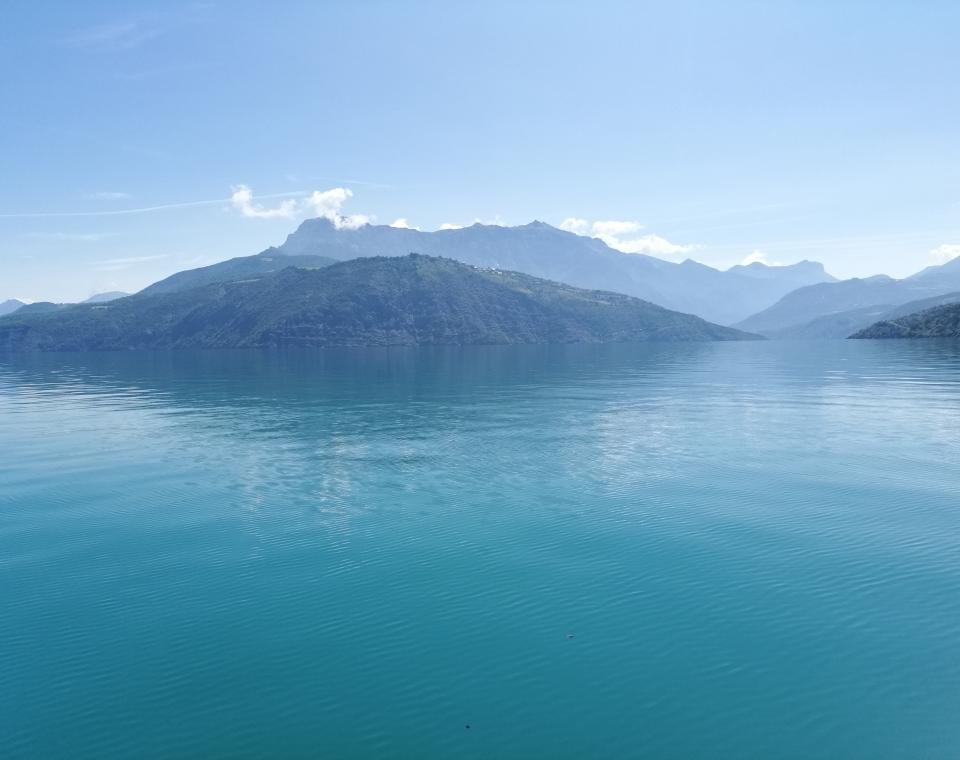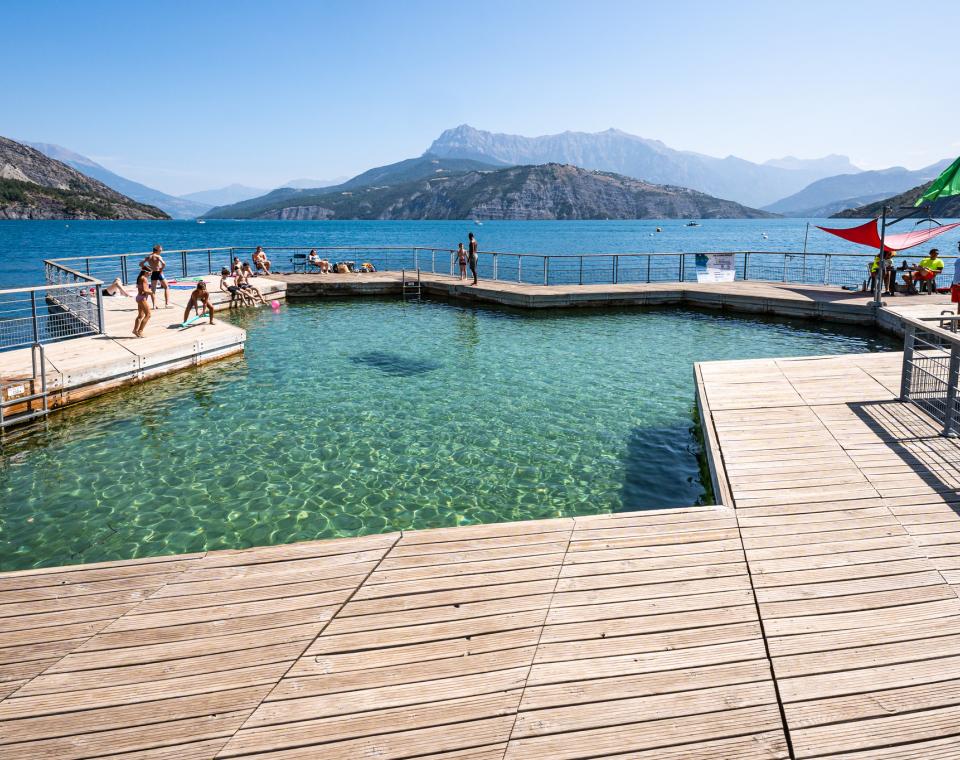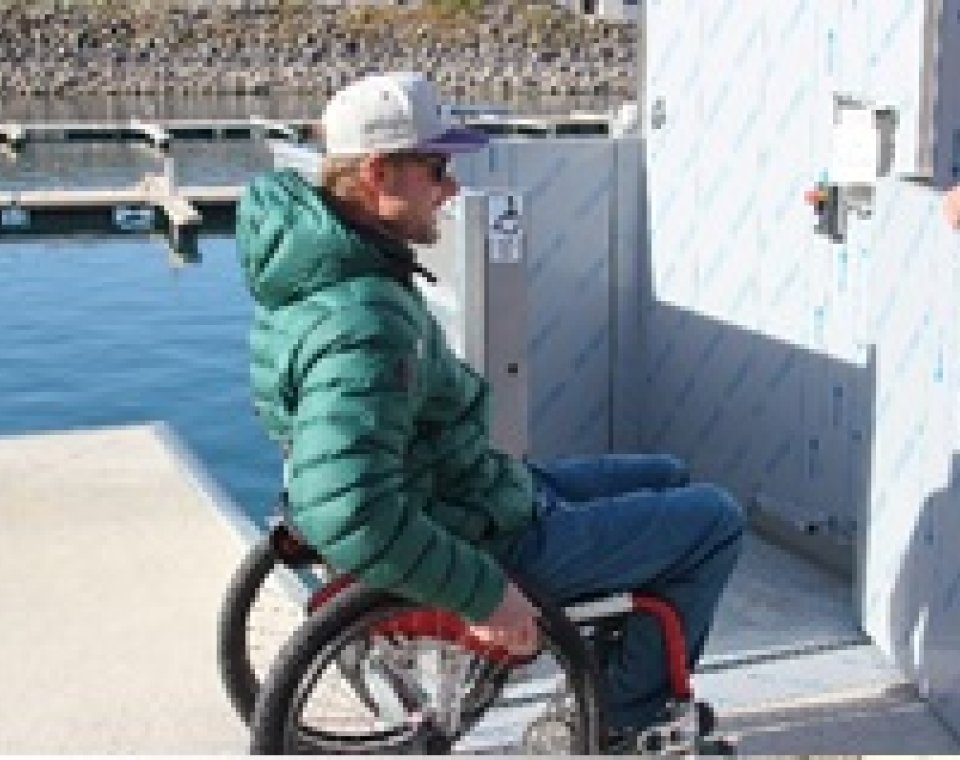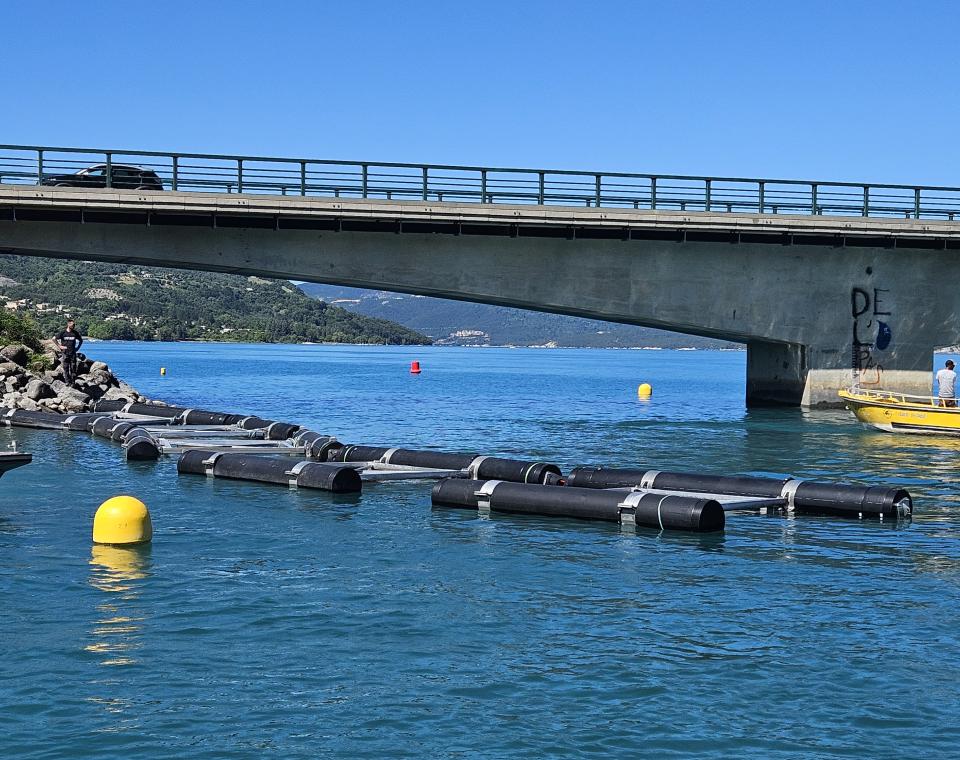Hydrobiological study - INRAE project
Since 20214, an environmental observatory on the lake has been working to improve water quality in the reservoir, protect aquatic environments, species and natural habitats of heritage interest, and improve water resource management.
In 2023, the S.M.A.DE.SE.P. conducted the Vth hydrobiological study of Lac de Serre-Ponçon in close partnership with INRAe and OFB. This hydrobiological study aimsto characterize the functioning of Lac de Serre-Ponçon based on the physico-chemistry of the water and sediments, as well as planktonic biodiversity. The aim of the study is to highlight potential changes in the lake since previous studies, both in terms of water quality and plankton populations .
Finally, the study should make recommendations for "long-term" monitoring for the environmental observatory, to give future studies greater temporal coverage and sampling frequency than a "simple" ten-year analysis of the lake's state of health.
S.M.A.D.E.S.E.P. and INRAe have agreed to conduct a shared research and development program for this hydrobiological and piscicultural study of the Serre-Ponçon reservoir.
Land management in partnership with the Conservatoire du littoral
While the Syndicat de Serre-Ponçon is resolutely committed to the quality development of the tourist areas around Lac de Serre-Ponçon, it is well aware that the primary economic wealth of its territory lies in the quality of its environment and landscapes. The development policies it pursues in order to create local employment must therefore be balanced with strong preservation actions: in other words, the tourist appeal it aims to strengthen with a qualitative approach must not lead to the deterioration of the heritage on which much of this same appeal is based. In the future, it should be possible to sail from a perfectly equipped port or beach into an environment that seems paradoxically "wild". For this reason, the syndicat has entered into a close partnership with the Conservatoire du littoral, a public establishment without equivalent in Europe, whose mission is to acquire parcels of coastline, whether maritime or lacustrine, threatened by urbanization or degraded, to turn them into sites that are restored, developed and welcoming, while respecting the natural balance.
The aim of this partnership is to contribute to the preservation of Serre-Ponçon's outstanding natural and lakeside areas, and to build up a network of managed natural sites around the lake, whose economic, environmental and social value can be widely shared for the benefit of the local communities and their residents or visitors.
Once acquired, the Conservatoire's land is entrusted to managers who work on the basis of a management plan drawn up by the Conservatoire, to preserve and enhance the heritage of these areas. Lac des Bouchards in Savines-le-Lac, for example, is one such site, which has now been acquired and is soon to undergo similar environmental management.
The floating pool at Serre-Ponçon
The reservoir's tourist sites are unique due to the slope of the riverbank and the sensitivity it induces in terms of bathymetry. Steep slopes make shoreline development difficult, and significantly increase the risk of access for visitors and water sports enthusiasts. This situation is also found on the Bois Vieux beach (Commune de Rousset), closest to the dam. The bathing profile presents a risk due to the steep slope, making it impossible for the SDIS to provide surveillance in areas over 7 meters deep. To ensure the safety of this bathing activity, a major point of interest on Lac de Serre-Ponçon, the S.M.A.DE.SE.P. chose to install a floating basin rather than build a beach using cut-and-fill operations, which would have had a major impact on the site. Since 2015, an experimental prototype of a 250 m² floating pool has been positioned every summer season to guarantee free, original and perfectly safe swimming. For the rest of the year, the equipment, which weighs almost 60 tonnes when loaded, is "wintered" in a sheltered cove on the lake, almost 4 kilometers away.
Swimming is organized around two separate pools for up to 200 people: a 70 cm-deep paddling pool for children and a 1.50 m-deep swimming area for adults. The bottom and sides of these pools are made of composite wood slats, so that they are constantly fed by lake water, which requires no special treatment. The beaches around the pools are made of "natural" wood decking (class IV-treated Scots pine for durability).
Vegetated floating islands
The hydroelectric operation of the Serre-Ponçon reservoir (high winter tidal range, regular sediment deposits from the Durance, etc.) hinders the development of aquatic biodiversity.
As a result, the vegetation on the banks is very poorly developed, or even virtually non-existent, and it seems essential to provide a favorable habitat for the reservoir's fish species.
The UROS project is designed to support the stock of identified species - such as pike and roach - for the proper ecological functioning of Lac de Serre-Ponçon.
The French Office for Biodiversity (OFB), the French National Research Institute for Agriculture, Food and the Environment (INRAE) and the ECOCEAN company, in partnership with the S.M.A.D.E.S.E.P., have carried out a research and development project on the Serre-Ponçon lake, aimed at developing floating, vegetated artificial islands to recreate a riparian zone permanently available for biodiversity.
The primary objective was to recreate spawning and nursery areas for "phytophilous" fish populations (these species normally need plant support to fix their annual spawning). These floating structures, installed in September 2018 on the lake, were intended to provide areas of submerged substrate and vegetation conducive to species reproduction and protection of young fry, as well as colonization by invertebrates and aquatic microorganisms.
Thanks to the scientific monitoring carried out or aggregated by the project partners, an evaluation of the system has revealed an ecological gain for the biocenosis of Lac de Serre-Ponçon and its banks. This favorable assessment, which the S.M.A.DE.SE.P., INRAe and the OFB are now seeking to measure over a longer timeframe (a follow-up of 5 additional years has been agreed, starting in summer 2022), is leading the syndicat mixte to study applications on its harbor pontoons or on larger floating islands (the scale of implementation could be a multiplying factor in the effectiveness of the biological device).
The PMR lift at the Capitainerie
The harbour master's office has installed a PRM elevator to enable people with reduced mobility to access the floating pontoon from the quay. This unique piece of equipment has been the subject of a research and development agreement with the Poralu company, with a view to designing an elevator that can adapt to the tidal range, at a fraction of the cost previously required for equivalent systems.
As part of its development strategy, the S.M.A.DE.SE.P. is committed to making port and seaside infrastructures accessible to all. This "full-scale" experiment could enable other nautical destinations to provide efficient facilities, at about half the cost of existing facilities.
The breakwater pontoon
The tidal range required for pleasure boating is a reality that has a major impact. This raises the question of how to adapt pontoons and moorings to the low water levels at which the lake is filled, in order to maintain their usability, at least in part. In this respect, the Serre-Ponçon reservoir is unique and calls for innovation in terms of port facilities. With a capacity of 1,250 moorings on the reservoir, yachting is a major nautical attraction.
Ensuring the long-term future of this activity remains essential to the economic vitality of the destination, which proposes to secure it by extending and moving the harbours to make them resilient to higher tidal ranges..
Simple, you might say? let's position the mooring buoys further offshore, where the bathymetry is greater!
However, these offshore buoys are sometimes subject to severe weather conditions (winds), posing the problem of their accessibility from the shore when the lake is at its fullest. It wouldn't be very serious to expect yachtsmen to be able to row hundreds of meters to their boats!
Extending the pontoons, whose ends will thus run aground at lower bathymetry and further from the shore, therefore seems to be the only solution to this complex problem. However, it may raise issues of landscape integration and safety, given the exposure of these infrastructures to the wind (waves of up to 0.80 m on the lake).
For this reason, the installation of physical protections, hitherto in the form of dikes or sea walls, is a prerequisite for adapting port infrastructures to the tidal range, which global warming may logically accentuate. With a view to ensuring reversibility, reducing the impact on the landscape at low water levels, and keeping costs under control, the S.M.A.DE.SE.P. is now considering the installation of "breakwater" pontoons, which could make offshore yachting safer, without the need for highly impactful developments.
Although the technique of floating concrete pontoons has been used for decades on the sea coast, the difficulties of beaching and the variability of water levels in the reservoir make it unlikely to be considered for Serre-Ponçon. Although metal technologies have not been totally ruled out, initial feasibility studies are focusing on "flexible" alternatives to be invented on site: systems linking polyethylene modules are now being sketched out and should soon be tested as a preview on the large lake in the Southern Alps.
Adapting our seaside and nautical beaches
The threat of climate change is becoming clearer by the day, directly threatening the lake's bathing and boating activities. The drought of 2022 was a case in point, highlighting both the lack of management of the lake at low water levels and the difficulty for downstream users to measure their direct responsibility in the summer drawdown of the reservoir. The drought resulted in a considerable drop in the level of Lac de Serre-Ponçon, which reached 763 m NGF at the end of August (i.e. -17 m below its maximum operating level). Although many socio-professional players have shown great resilience with the help of the syndicat mixte, this exceptional tidal range during the high tourist season calls for a significant increase in the adaptation of nautical infrastructures, in order to ensure the long-term safety of the many activities they host.
Development of nautical beaches
The aim is to enable water sports such as light sailing, paddling and canoeing to continue for as long as possible. The aim is to create large, evenly-profiled areas, free of obstacles and slope breaks that pose major risks to these activities. Rather than adding covering materials (pebbles) everywhere, which seems excessive in view of the size of the areas to be treated, it will probably be preferable to crush the hard materials present on site: this technique eliminates potentially dangerous blocks, while creating a protective "shell" on ground that may be muddy (in addition to the discomfort they cause, wave action causes the water to become very turbid, generating an additional safety risk).
Beach extension Beach extension
the aim is to make the eight public beaches equipped for bathing and supervised accordingly safer. The aim of the project is to extend the existing development to bathymetry levels of -5 to -8m, down to a minimum of -15m where possible: the planned work involves reshaping the shoreline and adding local materials (generally Boscodon pebbles) to protect the beach from the effects of muddy bottoms (water turbidity, potential sinking, comfort for swimmers, etc.).
While the addition of these materials to the bottom of the lake seems highly favorable to fish development, the granulometry chosen is primarily intended to ensure the stability of these aggregates with respect to wave action*. A study to determine the granulometry per beach (according to its slope) accompanies the adaptation of these different beaches.
*wave action: all the upheavals up to and including waves, caused either by the motion of a boat, or by thewind1. This volume of water breaking against the banks causes them to deteriorate.









